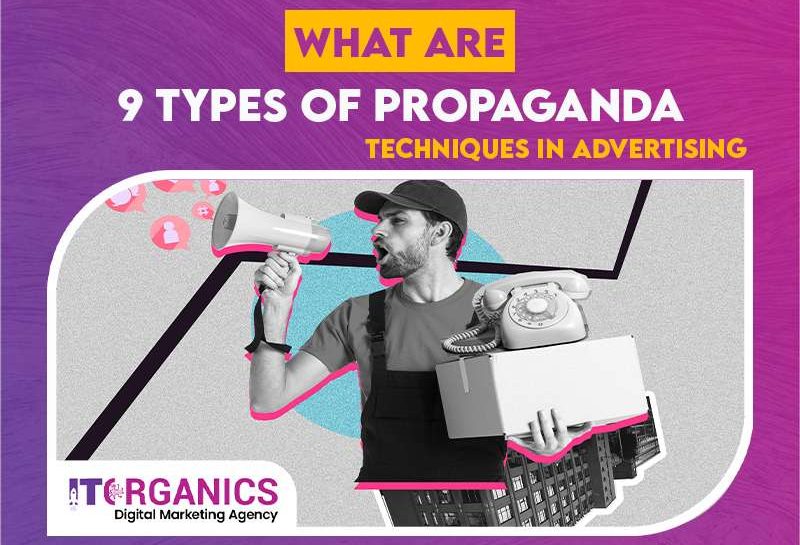
What Are 9 Types of Propaganda Techniques in Advertising?
Advertising shapes our choices more than we realize. Brands use different tools to capture attention and influence decisions. One of the techniques is propaganda techniques. These are not just political tools. They are common in the business world, especially in marketing campaigns.
Whether you are buying a soft drink, choosing a phone, or picking a skincare brand, you may be influenced by propaganda techniques without even knowing. They work by appealing to emotions, creating urgency, or connecting products with ideas we value. From celebrity endorsements to “everyone is using it” trends, these techniques drive millions in sales every day.
At IT Organics, we understand that modern advertising is complex. Consumers today are exposed to thousands of brand messages daily. Our role is to help businesses use ethical marketing practices that inform, not mislead. While propaganda techniques can be powerful, they should be applied responsibly to build long-term trust.
IT Organics helps brands create impactful campaigns without crossing the line into manipulative advertising. We combine creativity with market research, ensuring messages are clear, truthful, and targeted.
By the end of this article, you will be able to spot these techniques easily. More importantly, you will see how they can be adapted ethically in today’s digital world.
Understanding Propaganda in Advertising
Propaganda techniques in advertising are intentional forms of communication used to influence any given audience to act, think, and/or feel in a certain way. Propaganda techniques can be either subtle or overt.
For instance, businesses utilize propaganda techniques to promote benefits, create emotional connections to their products, or persuade consumers to purchase their product rather than a competitor’s. They rely on psychology. That is why techniques like testimonial propaganda or bandwagon propaganda work so well
Propaganda Techniques
|
Description | ||
| Card stacking propaganda | Showing only the positive side of a product. | ||
| Testimonial propaganda | Using a famous or trusted person to endorse a product. | ||
| Transfer propaganda | Linking a product with positive values or images. | ||
| Bandwagon propaganda | Suggesting everyone else is using it, so you should too. | ||
| Name calling propaganda | Attacking competitors to make your product look better. | ||
| Stereotyping propaganda | Using generalizations to target specific groups. | ||
| Emotional appeal | Targeting feelings like fear, joy, or nostalgia. | ||
| Glittering generalities | Using vague but attractive words. | ||
| Plain folks appeal | Showing the product is for “everyday people |
1. Card stacking propaganda
This method focuses only on the good points. For example, a snack brand may show “low fat” but hide “high sugar.” It is about selective presentation. Businesses sometimes use card stacking propaganda examples in diet product ads.
2. Testimonial propaganda
Here, a famous figure endorses the brand. When a sports star says they use a certain drink, fans want to try it too. Testimonial propaganda builds instant trust.
3. Transfer propaganda
This method links a product with desirable values. For example, a perfume ad showing romance and elegance is using transfer propaganda examples.
4. Bandwagon propaganda
People want to belong. Ads with “join millions of satisfied customers” are classic bandwagon propaganda. Bandwagon propaganda examples include tech launches with massive pre-orders.
5. Name calling propaganda
A brand may highlight flaws of rivals. Name calling propaganda examples appear in political ads and sometimes in competitive marketing.
6. Stereotyping propaganda
This technique uses group labels. Stereotyping propaganda in fashion may suggest a style is “only for real men” or “perfect for classy women.”
7. Emotional appeal
It makes people feel something strongly. Charity ads showing suffering children are examples.
8. Glittering generalities
These use big, vague promises like “the ultimate experience” or “pure happiness.”
9. Plain folks appeal
It shows normal people using the product. It says, “This is for you.”
Connecting Propaganda with Other Marketing Strategies
Propaganda does not exist alone. It blends with digital marketing, influencer marketing, and branding. In the digital space, propaganda examples frequently show up in social media campaigns.
Search engine optimization can also connect with propaganda. For instance, using strong positive keywords in ads is like a digital version of card stacking in propaganda.
Email marketing often uses emotional triggers, similar to transfer propaganda, to make customers feel urgency or excitement.
By combining propaganda techniques with analytics, businesses can test which emotional triggers work best. But the ethical use of these tools is important to protect brand reputation.
Why These Techniques Work So Well
- They simplify complex choices.
- They create emotional bonds.
- They influence without appearing forceful.
For example, a company selling eco-friendly products might use transfer propaganda to link purchases with saving the planet. The emotional reward is as strong as the product benefit.
IT Organics’ Role in Ethical Advertising
At IT Organics, we guide clients in using propaganda techniques without misleading customers. We focus on:
- Honest storytelling
- Data-driven audience targeting
- Transparent product details
We believe brands can leverage persuasive communication, without being dishonest.
Final Words
Advertising is effective on both logic and emotion. Propaganda techniques encourage us to see a product in a certain way, which can make the product more compelling. Like any tool, they are responsible to use.
We have explored 9 types of propaganda techniques in advertising, which range from card stacking propaganda to testimonial propaganda, each technique has its own potential. The techniques help brands connect with people, they should also be responsibly used.
Propaganda examples are everywhere in ads.
Types of propaganda include emotional appeal and social proof.
Card stacking in propaganda hides the negatives.
Transfer propaganda connects products with emotions.
Bandwagon propaganda plays on the desire to belong.
Name calling in propaganda attacks rivals.
Stereotyping propaganda targets specific groups.
Ads may use propaganda techniques subtly or directly.
At IT Organics, our mission is to help brands use these tools ethically. We help you reach your audience, communicate clearly, and build trust. While propaganda techniques can create immediate interest, only honesty sustains customer loyalty.
We provide creative content, digital strategy, and research-backed approaches that respect consumer intelligence. This balance between persuasion and truth is what makes our clients’ campaigns stand out.
If you are ready to use the art of influence without losing integrity, IT Organics can guide you. Ethical persuasion is possible and it works better in the long run.
FAQs
Which propaganda techniques are most frequently used in today’s advertising?
The most common are
- Testimonial propaganda
- Bandwagon propaganda
- Transfer propaganda.
These connect products to emotions, trust, or a sense of belonging.
How do businesses use propaganda techniques online? Businesses use propaganda methods by sending social media ads, influencer partnerships, and email campaigns. Advertisers combine propaganda techniques with SEO strategies and data analytics to effectively reach their target audience.






